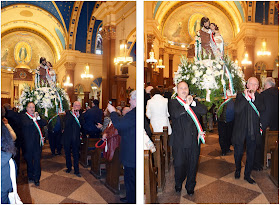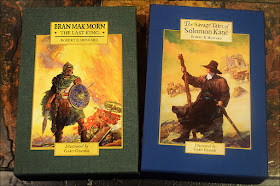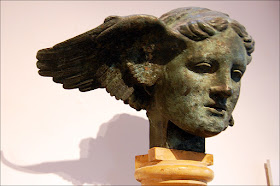 |
| Maschio Angioino (also called Castel Nuovo, or New Castle), Napoli Photo by New York Scugnizzo |
March 27, 2019
March 22, 2019
The First Decade
 |
| Illustration courtesy of John M. Viola |
“Never let the perfect be the enemy of the good” ~ Charles Coulombe, Off the Menu: Episode 89
If you really want to help us carry on and you can’t contribute constructive content or participate in our public ventures, we are happily accepting donations in the form of prayers. If you like what we do and want us to continue doing it, please say a prayer for us. Your generosity and thoughtfulness are greatly appreciated. God bless you all.
March 19, 2019
Evviva San Giuseppe! A Look at the 2019 Festa di San Giuseppe in Ridgewood, Queens
 |
| Due to the fragile condition of the traditional processional statue, organizers borrowed one from St. Francis of Paola Church in Williamsburg, Brooklyn Photos by New York Scugnizzo |
 |
| (Above & below) Devotees carry San Giuseppe from the Notre Dame Catholic Academy gymnasium to Our Lady of the Miraculous Medal Church |
 |
| The statue is placed near the altar in the sanctuary |
 |
| (Above & below) A look at the newly painted church |
 |
| The church has a beautiful semidome above the altar |
 |
| After Mass, the statue is processed out of Miraculous Medal Church |
 |
| A large crowd of devotees gather outside the church for the procession |
 |
| Donations are pinned to the statue |
 |
| Our friends Anna and Franca from the Our Lady of the Snow Society |
 |
| The procession departs from the church |
 |
| The Giglio Band |
 |
| (Above & below) The procession wends its way through the neighborhood |
 |
| Along the way, devotees greet us with their own statues of St. Joseph |
 |
| After a couple of hours the procession makes its way back to the church |
 |
| (Above & below) San Giuseppe is returned to the gymnasium with great fanfare |
 |
| Partygoers stand for the National Anthem before the refreshments |
 |
| President Tony Mulé kicks off the festivities |
 |
| Our dear friend Stephen La Rocca, President of the St. Rocco Society, is honored for his devotion and generosity to San Giuseppe |
 |
| Loaves of blessed bread and prayer cards are distributed to the pilgrims |
 |
| Children help draw the numbers for the raffle contest |
 |
| This year's prizes included statues of the Holy Family and San Giuseppe |
 |
| A few cuties with their beloved patron |
March 18, 2019
Photo of the Week: Torquato Tasso, Sorrento
 |
| Statue of the 16th-century poet from Sorrento, best know for his epic poem Gerusalemme liberata (Jerusalem Delivered), Piazza Tasso, Sorrento Photo by New York Scugnizzo |
March 17, 2019
Meridiunalata XI: "Hjumara" by Achille Curcio
De tutti li jochi chi fici guagliuna
non resta cchiù nenta nte chista sirata;
eppuru sti strati, stu vecchiu portuna
mi furu cumpagni nte chiddha jornata,
chi tuttu era jocu, chi tuttu era cantu
si u celu mustrava d’azzurru nu mantu.
De tutti i speranzi cuvati nt’o cora
non resta na scagghia cà tuttu spariu;
chist’anima trema videndu cà fora
na negghia passandu stu celu tingiu
e tuttu cumpara de niru velatu
stu mara, stu sula, stu nundu cangiatu.
Nte chista sirata domandu a lu ventu
duva iddhu portau la mia giovinezza;
e duva mo porta stu caru lamentu
de st’anima nira, cchiù nira ‘e na pezza.
Lu ventu respunda cà tuttu scumpara,
cà resta la vita na vera hjumara.
Hjumara chi porta luntanu l’affanni
d’o riccu signora, d’o peju sciancatu
li belli jornati, l’amuri e li nganni,
speranzi, suspire, nu sonnu spezzatu.
Hjumara maligna chi tuttu trascina
e poi cu nu vuddhu ti scriva la fina.
River
By Achille Curcio (1974)
Translated by Cav. Charles Sant’Elia
Of all the games I played as a child
Nothing is left in these evenings;
Even these streets, this old great doorway
Were my companions in those days,
When all was a game, when all was song
If the sky shown itself as a blue mantle.
Of all the hopes lodged in my heart
There is left not a splinter, for all disappeared;
This soul trembles seeing that outside
A passing fog stained this sky
And all appears veiled in black
This sea, this sun, this changed world.
In this evening I ask the wind
where he brought my youth;
and where he now brings this dear lament
of this blackened soul, blacker than a rag.
The wind responds that all disappears,
that life remains a true river.
River that brings afar the grief
of the rich lord, of the worst off beggar
the beautiful days, love and deceits,
hopes, sighs, a shattered dream.
Evil river that drags everything
And then with an eddy writes your end.
* Self-published in 2010, Meridiunalata/Southernade is a treasury of poems gleaned from Cav. Sant'Elia's previous collections (Nchiuso dint''o presente, 'A cuntrora, and 'O pino e l'éllera), which were circulated among friends in New York City and Naples. Special thanks to Cav. Sant'Elia for allowing us to reprint his poetry and translations.
March 13, 2019
Binging on Fiction: A Welcome Blast From My Geeky Past
Know, O prince, that between the years when the oceans drank Atlantis and the gleaming cities, and the years of the rise of the Sons of Aryas, there was an Age undreamed of… (1)
Some choice reads from my bookhoard
 |
Robert E. Howard’s The Ultimate Triumph, illustrated by Frank Frazetta and The Complete Chronicles of Conan, illustrated by Les Edwards
|
 |
Deluxe editions of Robert E. Howard’s Savage Tales of Solomon Kane and Bran Mak Morn: The Last King, illustrated by Gary Gianni
|
 |
L. Sprague and Catherine Crook de Camp’s The Incorporated Knight and The Pixilated Peeress
|
Know, O prince, that between the years when the oceans drank Atlantis and the gleaming cities, and the years of the rise of the Sons of Aryas, there was an Age undreamed of, when shining kingdoms lay spread across the world like blue mantles beneath the stars - Nemedia, Ophir, Brythunia, Hyperborea, Zamora with its dark-haired women and towers of spider-haunted mystery, Zingara with its chivalry, Koth that bordered on the pastoral lands of Shem, Stygia with its shadow-guarded tombs, Hyrkania whose riders wore steel and silk and gold. But the proudest kingdom of the world was Aquilonia, reigning supreme in the dreaming west. Hither came Conan, the Cimmerian, black-haired, sullen-eyed, sword in hand, a thief, a reaver, a slayer, with gigantic melancholies and gigantic mirth, to tread the jeweled thrones of the Earth under his sandaled feet. ~ The Nemedian Chronicles
From Italy they visited Germany and France. I, their eldest child, was born at Naples, and as an infant accompanied them in their rambles.
There, in a lonely land and gloomy cells,
The dusky nation of Cimmeria dwells;
The sun ne’er views the uncomfortable seats,
When radiant he advances or retreats.
Unhappy race, whom endless night invades,
Clouds the dull air, and wraps them in shades.
March 11, 2019
Photo of the Week: Marble Bust at Axel Munthe's Villa San Michele in Anacapri
 |
| Marble bust in the loggia at Axel Munthe's Villa San Michele in Anacapri, Capri Photo by New York Scugnizzo |
March 9, 2019
Distributing Food to the Homeless on the Feast of St. Thomas Aquinas
Thursday, March 7th, members of the Constantinian Auxiliary prepared and distributed food to the homeless in Chinatown and Two Bridges, New York on the Feast of St. Thomas Aquinas. Meeting at the Church of the Transfiguration (29 Mott St.), volunteers braved the frigid weather and prepared 20 care packages replete with winter accessories, toiletries and ready to eat food, including containers of freshly cooked penne marinara generously donated by our dear friends at Caffé Napoli (191 Hestor Street) in Little Italy.
Thank you to this month's volunteers
Once again, we want to thank Antonio, Anna and Konstantinos Mavrianos-Cesare for their hard work and dedication. You are an inspiration to us all. Thank you Louis Fontana of Caffé Napoli; Raymond Guarini of the Italian Enclaves Historical Society; Andrew Giordano of the St. Rocco Society; Robert Michael Surella of the East Harlem Giglio Society; Olya Brandon; and Cav. John Napoli for your continued assistance. Your heartfelt generosity and selflessness is greatly appreciated. And as always, special thanks to Pastor Lo for your support and blessings. It is an honor to serve with such an outstanding group of people. God Bless you all. IHSV
Anna and Konstantinos
The next walk will be on Thursday, April 4th—the Feast of San Benedetto da San Fratello—at 7:00 PM. In addition to ready to eat foodstuff and daily necessities, we’re are asking volunteers to donate hats and scarves for the cold weather. Anyone interested in supporting this charitable endeavor can contact Cav. John Napoli at jnapoli@smocsg.org or Anna Mavrianos-Cesare at MsAnnaNY@aol.com.
 |
| Once again, our friends at Caffé Napoli donated a tray of penne marinara |
 |
| Everybody pitched in |
 |
| Konstantinos and Olya |
 |
| Bobby |
Originally posted in The Constantinian Chronicle
The Search for our Ancestry (LVII)
I’ll begin with the earliest presentation of names, those in sacramental church records, made before the time that ‘civil’ record-keeping began in Sicily and the northern duchies and civil states of the Apennine peninsula (that is, before the early 1800’s). The sacraments involved were baptism, chrismation (confirmation), marriage and extreme unction. Because extreme unction is the sacrament administered just preceding death, these latter church records are termed ‘death records.’ The earliest church records (as early as the 15th century), and in many cases those to this day, were written in the official church language, Latin. Here are points to remember about names in Latin records:
 ‘Given’, or ‘first’ names are usually different than they are in the Italian language. The Latin for Giovanni is Joannes; for Felice it’s Felix; for Orazio, it’s Horatio; for Vincenza it’s Vincentia; Grazia is Gratia, and so on. This is more the case for masculine names, where virtually all have differences between Latin and Italian. Many feminine names are the same in Latin and Italian: Maria, Angela, Rosa, etc.
‘Given’, or ‘first’ names are usually different than they are in the Italian language. The Latin for Giovanni is Joannes; for Felice it’s Felix; for Orazio, it’s Horatio; for Vincenza it’s Vincentia; Grazia is Gratia, and so on. This is more the case for masculine names, where virtually all have differences between Latin and Italian. Many feminine names are the same in Latin and Italian: Maria, Angela, Rosa, etc.Surnames or family names are usually the same in Latin as in Italian.
Given names vary with the usage of the name in the record. A marriage record for Antonio Russo, son of Angelo, e. g., would list Antonius and Angelus (the declarative forms) in the margin, but the actual record would say the groom was ‘filius Angeli’, where ‘filius’ means ‘son’ and ‘Angeli’ means ‘of Angelus’. The ‘i’ ending on a masculine name that normally ends in ‘us’ is the ‘genitive’ form, carrying the meaning ‘of’ or ‘from’. For feminine names ending in ‘a’, the genitive ending is ‘æ’, usually handwritten to look like an uppercase ‘E’. So ‘filius Mariæ’ means ‘son of Maria’; ‘filius Rosæ’ means ‘son of Rosa’, etc.
A potentially confusing aspect of Latin names is that in many cases, they are different from the corresponding Italian names, but the same as the eventual ‘Americanized’ name. The Italian name ‘Giuseppe’ is ‘Joseph’ in church Latin; ‘Michele’ is ‘Michael’ in Latin; ‘Felice’ is ‘Felix’ in Latin; and ‘Elisabetta’ is ‘Elisabeth’ in Latin. See my web page at http://bit.ly/LatinGivenNames
Once civil records were kept for births, marriages and deaths, they were written in the official language of the region. Even though there was no nation known as ‘Italy’ prior to 1861, the official language was Italian. Many descendants of immigrants knew their nannu or nanna only by the short family-used versions of their Sicilian/Italian given names. A brief list of these follows. For more, see http://bit.ly/ShortenedSicilianNames
March 8, 2019
Happy Women’s Day!
 |
| Nonna Pauline |
Lace
In small Mediterranean towns
women, stooped, and girls
with rag-soft bodies
are making lace intricate as brain circuitry.
See how the light spins through,
imprinting the wall—
not with a maze, but a map
to trace your way home
to women yet unborn who’ll find
the lace at the bottom of a cedar chest,
and marvel.
When the world is like a skein
unravelling, look again to the lace: see
how absence forms its pattern,
and purpose fills even the smallest space.
* Reprinted from Eye to Eye: Poems by Maria Terrone, Bordighera Press, 2014, p. 104
March 4, 2019
Photo of the Week: Bronze Head of Hypnos at Axel Munthe's Villa San Michele in Anacapri
 |
| Bronze head of Hypnos, the Greek god of sleep, in the loggia at Axel Munthe's Villa San Michele in Anacapri, Capri Photo by New York Scugnizzo |
March 2, 2019
New Books (March 2019)

New and forthcoming titles that may be of interest to our readers. All are available at Amazon.com
• The Neapolitan Lives and Careers of Netherlandish Immigrant Painters (1575-1655) by Marije Osnabrugge
Publisher: Amsterdam University Press
Publication Date:
Hardcover: $137.75
Language: English
Pages: 416
Read description • The Complete Poetry of Giacomo da Lentini translated by Richard Lansing
Publisher: University of Toronto Press
Publication Date: May 4, 2018
Paperback: $23.35
Language: English
Pages: 208
Read description
Sold by: Amazon Digital Services LLC
Publication Date: March 4, 2019
Kindle: $0.99
Language: English
File size: 1790 KB
Read description
Click here to see more books
Listing does not imply any endorsement










